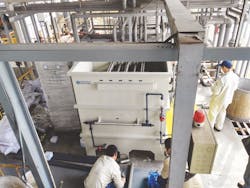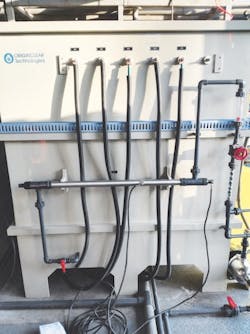JL Kindler is president of OriginClear Technologies. Kindler can be reached at [email protected].
Clean water is the world’s most precious resource. It is necessary for the well-being of both humans and the environment, but in recent years, it has diminished in availability. As the population grows, economies develop and industry expands, water contamination becomes an increasing threat to the health of global communities. According to the United Nations, unless more complete wastewater practices are adopted by top wastewater producers, global business, food availability and, ultimately, human lives could be at risk.
To effectively limit large-scale water pollution, implementing wastewater treatment solutions within industries that produce the most wastewater—namely agricultural and industrial operations—is an ideal first step. According to the United Nations, tackling contamination produced by these heavy-hitting industries offers the largest payoff in reducing global water contamination and associated public health risks.
Recently, it has become clear to industrial operators that centralized wastewater treatment is not a cost-effective means of contaminant reduction. In the U.S., only a few large treatment systems handle most domestic wastewater. Small facilities make up 80% of all plants but only process 10% of all wastewater. And continuing to invest in an aging infrastructure is breaking the bank. A study found that $271 billion is needed to maintain and improve the nation’s wastewater infrastructure, including the pipes that carry wastewater to treatment plants, the technology that treats the water and methods for managing storm water runoff. Furthering dependence upon the existing failing centralized wastewater infrastructure is a slow and expensive way to trudge forward. To meet the needs of today’s rapidly expanding industrial operations, efficient and decentralized wastewater solutions are needed.
Global Water Resources predicts that as water scarcity and environmental regulations tighten, operators not only in the U.S, but around the world are recognizing the value in a decentralized model in which water is treated on site. Onsite treatment with wastewater technologies allows facility managers to take control of their water use. Treatment can be tailored to the specific needs of the effluent produced, and in some cases, the treated water can be reused on site for cooling purposes.
Today’s popular wastewater technologies rely on biological processes. While these solutions are efficient at treating low to medium organic contamination loads, when applied to highly contaminated effluent, they lack long-term operational and economic efficiency. Other conventional treatment methods use disk tubular reverse osmosis membranes to sift out contaminants based on size. While relatively straightforward in theory, these filter-based treatment methods clog, requiring maintenance, which drives up onsite operating costs. As such, many industrial operators seek alternative wastewater solutions to meet discharge standards and address wastewater responsibly, efficiently and cost-effectively.
OriginClear has a treatment process called Electro Water Separation with Advanced Oxidation (EWS:AOx) that can efficiently treat any produced water on site. This process combines electrically induced gas flotation and advanced oxidation to remove both particulate and fully dissolved or miscible contaminants from waste streams without the use of oversized bioremediation tanks or the addition of large amounts of harsh chemicals.
EWS is a scalable and continuous process that uses small doses of electricity to gather oils and suspended solids for easy removal. AOx relies on powerful oxidants generated when the wastewater stream contacts a series of electrodes. The only chemicals that may be involved in the process are small amounts of simple chemical additives, such as sodium hydroxide, whose component atoms are part of, and vanish with, process reactions. It has a small onsite footprint, uses a low amount of consumables and treats even heavily contaminated wastewater in a matter of hours. With this process, industrial site operators have a budget- and environment-friendly wastewater treatment solution.
Treating Wastewater at a Chinese Manufacturing Facility
EWS:AOx technology was put to the test at a Chinese auto parts manufacturing facility in March 2018. The facility leveraged the wastewater treatment technology to meet strict wastewater quality standards in the region.
As a result of an onsite chrome-plating process, the manufacturing facility was producing wastewater that was variably high in ammonia, a contaminant that can lead to toxic buildup inside aquatic organisms if released directly into the surrounding environment. Due to the variability in the concentration of ammonia within the wastewater, site operators sought a treatment system capable of treating a range of contaminant levels.
The 8,100-gal-per-day system was the first commercial unit delivered by OriginClear and degrades ammonia from levels varying between 50 and 200 ppm to under 5 ppm. In the coming years, The company looks forward to providing similar systems to additional industrial operators throughout China.
As a major industrial hub, this project is just one of an expanding patchwork of wastewater treatment projects across China.
The EWS technology has been successfully tested in a wide range of industrial applications, including removing fats, oils and greases from dairy farm effluent and the onsite treatment of wastewater for a North Dakota electric utility. While each case is unique, the technology reduces all measures of non-soluble contamination to very low or undetectable levels. For example, it can remove up to 99% of free oil and fine, micron-sized suspended solids from water. It also is comparatively high-speed, cost-effective and low-maintenance in terms of energy and physical inputs. With the addition of AOx, the process can remove dissolved organic contaminants and notoriously hard-to-remove pollutants such as ammonia.
Clean water is essential to both industrial operations and environmental health. As environmental regulations tighten and manufacturing operations expand, operators recognize that effective onsite wastewater treatment is key—the challenge is finding an economic and comprehensive solution to meet their specified needs. In the years to come, distributed, highly efficient wastewater technologies will pervade the market and ensure the longevity of global clean water resources.



